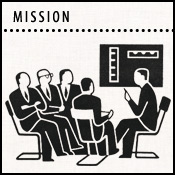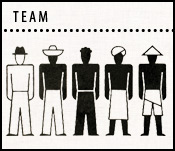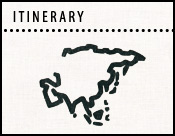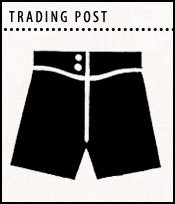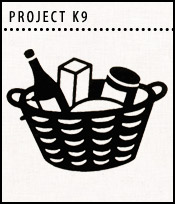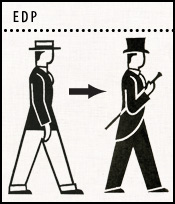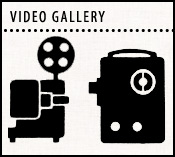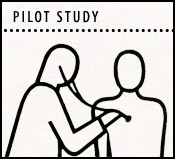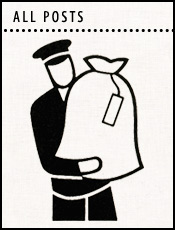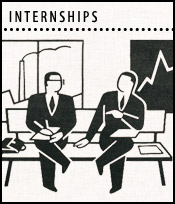We woke up once again in Uzbekistan to a giant feast, laid out on the kitchen table for us by Shoney’s mom. Most of the dishes from yesterday were there, with the addition of a kind of buttery fried gluten, like caramelized roux, which was spread on bread or eaten straight.

Shoney’s sister Luiza came out to join us, and we all goofed around, drinking coffee and trying not to be outsmarted by the little firecracker. She ate very little that girl, but could certainly throw back the Coca-Cola.
Our first mission for the day was to register. You see, dear reader, it is illegal to be in Uzbekistan for more than 72 hours without registering yourself with the government. So off to the registration and passport office we went, throwing our Speed TRs into a cab so as to be prepared to do a little wheeling later in the day.
When we got to the office, we locked our bikes outside and headed in. It was a two story, cheaply build Soviet structure, with sagging floors, now covered with flattened cardboard boxes, and peeling wallpaper. We began waiting in line, and scrutinizing the info-graphics on the wall explaining how one would be rewarded for turning in criminals.

Unfortunately, after waiting for quite some time in what turned out to be the wrong line, we were ushered to a new line and eventually into a room where a very grumpy woman looked positively crestfallen to see us.
“I am very sick today. I need a nap,†she exclaimed when we entered the room and indicated our intention to do the registration.
Shoney’s mother pressed on. “Fine then. I’ll need the full blueprints for your house detailing where they will be sleeping.†We of course did not have these. Shoney’s mother was not even sure she knew where to find them. So We walked out of the place empty handed. Fair enough.

We walked past the giant line of patiently waiting Uzbeks that had formed behind us, and past the gleaming black Mercedes 600 SEL, which was driven by the head of the office, and climbed back into a cab. We would need to think of a Plan B. One option would be to work with a hotel, who might register us for a cheap rate, given we wanted just the registration and that we weren’t staying with them. We talked about that for a while, but soon were distracted by the city of Tashkent flying by outside our window.
Our next stop was to meet up once again with Shoney’s grandfather, Nazarkulov.

We met him in the large central square where the government put most of its flashiest buildings and monuments. It’s place called Mustaqillik Maydoni, or Independence Square. We locked our bikes to a tree, where a nearby Somsa and drinks vendor had agreed to keep an eye on them.

Then we began strolling, and Nazarkulov began explaining to us the history of the square using this sign as a diagram. The square had first contained a statue of the Tsar. You see, Uzbekistan was first a colony of Imperial Russia. Then when the Soviets took control of the Russian empire it became a state of the CCCP, and the statue was replaced with one of Lenin. Then with the fall of the Soviets, the square was redone a few more times to bring it to its present state.

And what a state it was, with a giant monument showing the globe with Uzbekistan as the only country and a huge field planted with Siberian evergreen trees (each of which required it own shading device in order to keep it from withering in the Uzbek dry heat). We continued on into a nicely manicured and shady park, past old Soviet gardening trucks, to the Uzbek WWII memorial.

It was quite a memorial, and startlingly touching. The Soviets were very successful in the Second World War, but their methods for making war required some of the most reckless losses of human life ever recorded on our planet. In WWII 350,000 Uzbek Soviets died fighting against the Axis.

We wandered through the monument, where the names of each fallen Uzbek were carved onto great copper sheets, and collected like the pages of a book. Shoney and his grandfather struggled to locate the names of their own fallen relatives.

We moved from the monument out into the shadow of a giant pillared archway. On the top of the arch was a giant stork, the symbol, here too, of new birth.

We walked on past a giant fountain which had, in its hayday, blasted over a walkway, allowing visitors to walk through a tunnel of arcing water. It now sputtered weakly next to the walkway.

We sat down with Shoney and Nazarkulov in a special section of another nearby park to discuss Soviet times and this man Sharof Rashidov. Sharof Rashidov was an Uzbek leader during the Soviet times, made famous for his successful execution of an elaborate system of bribes and lies that convinced the Soviet government that Uzbekistan was producing more cotton and wheat than it actually was. This was of vital importance to the Uzbek people at the time, for they were not going to meet the quota that year, and would have suffered harsh consequences had they come up short.
Nazarkulov was quite the fan of Soviet Uzbekistan, spoke perfect Russian, and spoke passionately about how life was better during Soviet times.

Having toured Independence Square now for some time, we were all ready to eat some more. And so Nazarkulov took us to an chicken restaurant, established during the Soviet times. The chicken was incredible. It was served with a Bloody-Mary-esque sauce, which came in a little shot glass, and for a few cents more, your table could share a still-warm-from-the-oven loaf of Soviet style bread.

Not believing the reality of the pure volume of bills it took to operate in the Uze, we had attempted to pack our wallets with Ñум, figuring that we couldn’t spend it all in one day. Wrong we were, for just this cheap lunch took a huge chunk out of our pitiful wallet-sized wads.

Bellies full and wallets empty, we exited the restaurant and took a moment to take in the giant and mostly empty Hotel Uzbekistan, across the street, with its exquisitely filigreed front facade.
We then stuck out our arms, and the next car that passed stopped to pick us up. In case he did not agree to the price Shoney felt was fair, there would inevitably be another queued up behind him, ready to talk to us if we flagged the first one on. This cab system was amazing. We threw the cycles into the back of a black Chevy and headed off toward Shoney’s grandfather’s neighborhood, where a bike was waiting for Shoney.

The frame had been recently painted, and everything tightened up. It looked like a good ride, very 1983. And with some heartfelt thanks and goodbyes to Nazarkulov , we hit the road for a little inaugural Uzbek wheeling.
Traffic was light, and the roads were good, the main ones at least. Like everything else he applies himself to, Shoney wheeled hard and fast, heading on past giant Soviet apartment blocks and in toward the city center. Then, suddenly, Shoney’s tire popped, and the wheel ground to a halt.
We had a patch kit and pumps (in our seat posts), but what we needed was some water so we could see where the puncture was and patch it. The best water we could find was this river.

The river ran through a large Soviet sports club, where Shoney used to box. All the workers there were instantly skeptical of us, and just as instantly sympathetic when we explained the story of the flat. Some of the groundskeepers even offered us the use of one of their buckets.
But once we took the inner tube out, we found that no patch would solve this disaster, and thus no water was needed. The tube was an old cracked monster of a thing, and the flat had occurred because the valve nub itself had just torn free of the inner tube.

We would need a new inner tube, for sure. So we locked the bike inside the sports complex, grabbed the problem tire, and headed back to the streets where we caught a cab to the nearest bike shop. We ended up buying not only a new inner tube, but getting a package deal on a ridiculously cheap Russian-made tire as well. The man at the shop changed the tire and tube, and even pumped the thing up to show us all was legit.
Back in the park, we made short work of the repair, and headed back out to continue the wheel.

It was glorious to be wheeling again, sun bright, air fresh. Then a cop stopped us, and began to yell at Scott in Russian (of which he understood none) using very condescending language (Shoney later explained) and asking him what he thought he was doing. Turns out the cop had thought Scott was Russian and had some bones to pick with the Russkis. Shoney interjected in Uzbek, which surprised the cop a bit, explaining that we were American tourists and eventually he told us to wheel on, but reminded us that in Uzbekistan it was illegal to wheel more than one meter from the right side of the road, which if I am interpreting the law correctly, actually makes left turns illegal.
“They just want to have enough laws so that they can catch you breaking one of them at any time day or night,†Shoney explained. Fair enough.
We wheeled on toward the train station, stopping halfway through to grab some water from this M&Ms branded Produkti, which is the Russian answer to the convenience store. Â Or maybe the convenience store is the western answer to the Produkti; speculation is invited in the comments.
We wheeled on past giant new housing developments and old crumbling Soviet structures. Though most of the signs were in Russian, one also saw plenty of Uzbek too, which is these days written in Roman characters and looks like this:

We paused outside a the train station to let one of the many street trams go by.

The city really had some impressive public transit, for the capital of a country with a GDP per capita of just under $4,000. Sporting two metro lines and eight tram lines, it was very impressive. Also, as Shoney explained, traffic was a new thing to the city as well, having only arrived in the past couple years. Traffic jams were still a rarity.

At the Uzbek train station, we entered a terrible do-loop of waiting forever in the wrong line, then switching to a new line, then having it be wrong too. Eventually, we found the right line, though, and bought two tickets for the day after the next’s train to Samarqand.
On the way back to the house, we stopped by a certain hotel Shoney’s mother knew of, and bargained with them to register us. They were skeptical at first, but soon realized the opportunity to make some cash and agreed.
When we got back to the house, Shoney’s mother had made another giant meal for us, featuring a giant lamb and potato dish which, despite being extremely impressive, was presented to us with an apology!


![]()














































































































































